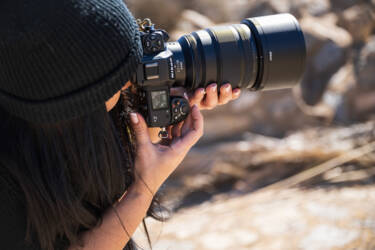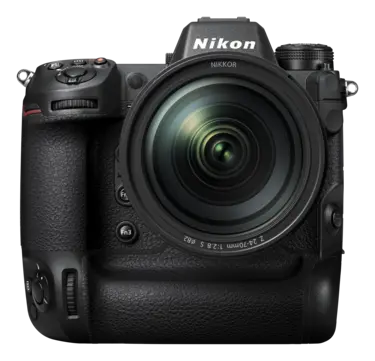Capturing athletes in motion with the Z 9 and Z 8
20fps burst speed, primes with wide apertures and 3D Tracking are the key to capturing athletes in motion, says sports photographer Lukas Schulze, ahead of an electrifying summer of sport
In between the European Championship and Germany’s football league Bundesliga, it’s no wonder that sports photographer Lukas Schulze has any time at all to sit down with Nikon magazine. The Cologne-based photographer, who regularly photographs for Getty Images and Adidas, likes a more stripped-back approach to photography, focusing on the action, emotions and atmosphere through a targeted use of focal length and aperture. Read on to uncover how to capture athletes in motion so you never miss a beat.
Use primes for wider aperture
“A sports photographer who doesn’t use zoom lenses?” laughs Lukas. “It’s unusual, isn’t it?” And while some might claim that using only prime lenses makes for a less flexible shoot, Lukas prefers the wider apertures primes afford. “I’d also rather take a step forward or backwards than zoom,” he explains. “In most cases, I also take photos with fixed focal lengths that fill the frame as much as possible so that the effect of the wide aperture – such as f/2.8 or 1/8 – is also more apparent.”
Kit up: Lukas uses the NIKKOR Z 400mm f/2.8 TC VR S on the Z 9, the NIKKOR Z 135mm f/1.8 S Plena or the NIKKOR Z 85mm f/1.2 S on his second Z 9 and the NIKKOR Z 28mm f/2.8 S on the Nikon Z 8. He also brings to matches the NIKKOR Z 14-24mm f/2.8 S and NIKKOR Z 50mm f/1.2 S.
Lukas Schulze
Z 9 + AF-S NIKKOR 200mm f/2G ED AF VR II with Mount Adapter FTZ II. 200mm, 1/1900 sec, f/2, ISO 1600, Exposure 0, ©Lukas Schulze for Handball-Bundesliga
Position yourself to advantage
With football, the first item on Lukas’ to-do list is discover who the top team is. “That influences my choice of side to stand,” the photographer explains. “Next, I look at how the light falls and position myself at the corner flag at the level of the goal line because great tackles can happen on the touchline.”
When composing, don’t neglect the crowds or the advantages of photographing in the stand, Lukas adds. The key is remaining fluid – on small pitches, you can switch up your position more, in large stadiums, much less. “In football – unlike track and field where athletes have set routines, and you can plan – you can never predict the action. Great action can happen anywhere,” he says.
Level up your sports knowledge
As with any assignment, study the sport you’re photographing in detail. “Develop a feeling for the movements, what looks aesthetic and what doesn’t,” Lukas says. “In track and field, I aim to photograph athletes at the peak of a movement – back leg stretched, front leg bent, for instance, and not stepping straight on one leg.”
Top tip: Look for perspectives the viewer wouldn’t expect and vary your angles.

Z 9 + NIKKOR Z 85mm f/1.2 S. 85mm, 1/2500 secs, f/1.2, ISO 640, Exposure 0 ©Lukas Schulze
Select continuous autofocus (AF-C) and 3D Tracking
Lukas photographs in continuous autofocus (AF-C) and uses 3D Tracking 95% of the time. In AF-C mode, when the subject moves, the predictive-focus tracking is automatically triggered. Turn on in ‘Photo Shooting Menu’, select ‘Focus Mode’, then ‘AF-C’. Next, select your subject detection options. For athletes, select ‘[People]’ and the camera will snap on your subject’s eyes.
Top tip: For extra ease, set up your custom controls with 3D Tracking. Under ‘Custom Settings Menu’, select ‘f controls’, ‘f2 Custom controls (shooting)’ then ‘FN2 [3D]’. Select ‘AF-area mode’ then ‘3D Tracking.’

Settings for outdoor sports photography
Click the button to play
Use a fast shutter speed of 1/2000 sec
“I choose all my settings manually and photograph in RAW,” Lukas explains. “I make sure I always have a fast shutter speed of at least 1/2000 sec and my aperture as open as possible.”
Top tip: Not yet ready to go Manual? Switch on Shutter Priority, a camera mode where you set the shutter speed (at 1/2000 sec for instance) and the camera automatically selects the aperture.

Z 6II + NIKKOR Z 14-24mm f/2.8 S. 14mm, 1/4000 sec, f/5.6, ISO 2500, Exposure -0.3, ©Lukas Schulze
20fps burst speed
You’ll need a high-speed burst rate for capturing athletes in motion. Under release modes, rotate the command dial on the Z 8 and Z 9 and select ‘Continuous high-speed’. Next, choose the frame rate. “I always use 20fps because I always shoot in RAW mode,” Lukas explains. Image quality is fixed at JPEG for high-speed burst photography at frame rates of 30, 60 or 120fps.
To go even further, set up Pre-Release Capture. This mode buffers images while the shutter button is half depressed up to one second. It can also record up to four seconds after you release the shutter button, meaning you’ll never miss an action shot. Pre- and post-burst mode can be set to 30fps or an incredible 120fps (JPEG only).
Look for off-pitch action
“The good thing about a big stadium is that there are always fans sitting around you,” Lukas says. If a goal is scored on the opposite side, I turn around and concentrate on the fans or the goalkeeper who is cheering on my side. I often go into the stands and take documentary photos from the spectators’ perspective to capture the viewer’s attention even better.”
Watch the light
Stadium matches often come with harsh shadows, where one half of the pitch is in shade and the other half is in the blazing sun. Or, perhaps, the half closest to the photographer is in the shade and the stands behind are in the sun. How does Lukas adapt?
“The key is adjusting exposure,” he says. “Nikon has a wonderful solution for this – the ability to call up a second exposure at the touch of a button. This function is called ‘Recall Shooting Functions’. I have assigned this to one of my function keys so that I can immediately switch to the adjusted exposure when the players run into the shadows. You can also play around with the light. Make the most of backlighting and photograph a silhouette.”
Where the assignment allows, try to photograph in the early morning or later in the evening for less harsh shadows.
D 5 + AF-S NIKKOR 105mm f/1.4E ED. 105mm, 1/8000 sec, f/1.4, ISO 50, Exposure 0. ©Lukas Schulze
How do you become a sports photographer?
For some, it’s the dream job. So, how did Lukas rise to the top?
“I started playing sports for FC Magdeburg and then, when I was ten years old, I switched to track and field at SC Magdeburg,” Lukas explains. “Years later, during a long break due to an injury, I bought a camera with the first money I earned myself and started photographing the track and field competitions. Some parents of the athletes then bought those pictures from me, and I was able to finance further equipment.
“Later, I studied photojournalism, completed an internship in the USA and also at the German Press Agency. Here, I learned, above all, how to work quickly and effectively in stressful situations. I was then able to further develop these skills during my two-year traineeship at the German Press Agency.
“My photos were seen by many colleagues which led to valuable contacts. After the end of the traineeship, I started my own business and started freelancing for Getty Images.”
Z 9 + AF-S NIKKOR 200mm f/2G ED AF VR II with Mount Adapter FTZ II. 200mm, 1/1900 secs, f/2, ISO 1600, Exposure 0. ©Lukas Schulze for Handball-Bundesliga
What’s one tip you have for aspiring sports photographers?
“It doesn’t make sense to jump straight into a big stadium at once as a sports photographer but, of course, you should have this as a goal,” Lukas says. “Everyone has to start small, just like every athlete. Find a local club that you can support with your photos and build up a portfolio that you can show off when the opportunity arises. But one thing is certain – although the rewards are great, earning a living with sports photography is hard work!”
Follow Lukas on his sports adventures here.
First image: D5 + AF-S NIKKOR 14-24mm f/2.8G ED.14mm, 1/1600 sec, f/3.2, ISO 1250, Exposure 0 © Lukas Schulze/Bundesliga/Bundesliga Collection via Getty Images
More in Sports and Action
Featured products
Uncover NIKKOR lenses

Unlock greater creativity










